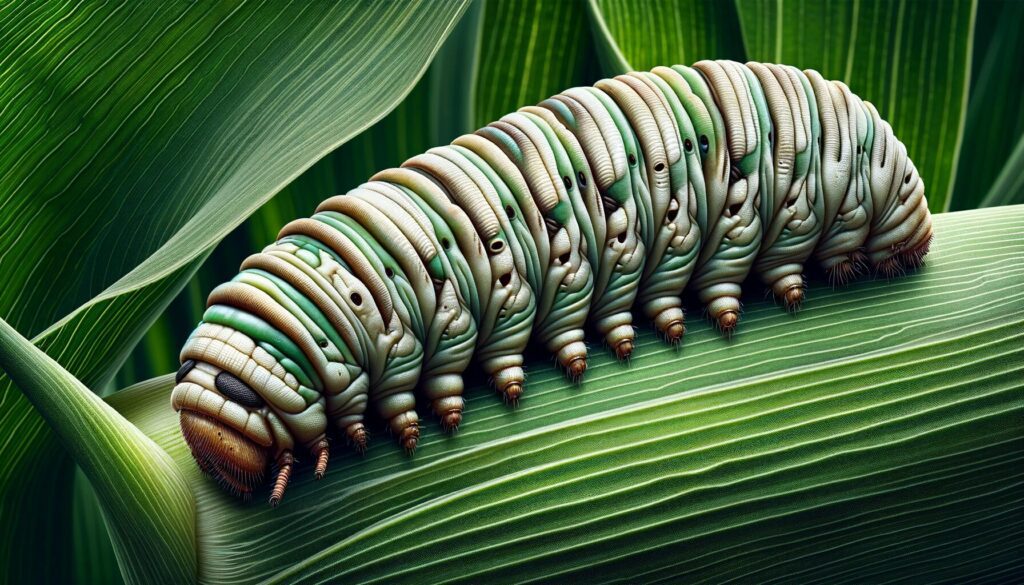Within the realm of pest management in crops, the armyworm, scientifically known as Spodoptera spp., represents a considerable challenge. This lepidopteran, in its larval stage, is capable of causing significant damage to a wide variety of crops. In this article, we will explore the characteristics of this pest, the impacts it can have on agriculture, and the most effective strategies for its control.

Characteristics of the Armyworm: How to Identify It
The armyworm is a moth larva that can vary in color from green to brown, with distinctive lines and spots along its body. They are known for their voracity and their ability to feed on different types of crops.
Originally, this pest is native to the tropical and subtropical regions of America, but in recent years, it has spread to other parts of the world.
In America, it is found from the southern United States to Argentina and Chile, covering a wide range of climates and agricultural areas. In Africa, the armyworm was first detected in Nigeria in 2016 and has since rapidly spread to several countries on the continent, causing concern among farmers due to its potential to devastate crops. In Asia, its presence has also been reported in countries such as India, China, and Thailand, among others.

The rapid expansion of the armyworm outside its original distribution area is partly due to globalization and international trade, which facilitate the movement of eggs, larvae, or pupae through agricultural products transported between continents. This pest is particularly difficult to control due to its ability to develop resistance to insecticides and its wide range of host plants, making it a significant challenge for food security in affected regions.
Crops Affected by the Armyworm
Spodoptera spp. is especially harmful to crops such as corn, cotton, soybeans, and tomatoes. However, it is not limited to these and can affect an even wider range of plants, both horticultural and ornamental.

Identification and Damage from the Armyworm
Identifying the presence of the armyworm (Spodoptera frugiperda) in a crop involves observing several characteristic signs and symptoms that this pest produces in affected plants. Here are some key indicators that can help you determine if the armyworm is present:
- Leaf Damage: Armyworm larvae begin by feeding on leaves, creating small perforations or transparent areas known as “windows.” As the larvae grow, the damage becomes more extensive, potentially consuming large portions of the leaf and leaving only the main veins.
- Presence of Larvae: Larvae are primarily responsible for the damage and can vary in color from light green to dark brown, with longitudinal lines along the body. Observing larvae directly in the crop is a clear indication of infestation. They tend to hide in the plant whorls during the day.
- Larval Frass: Larval frass (feces) is small black dots that can be found on leaves or around feeding areas, which is an indicator of their activity.
- Damage to the Whorl or Growing Point: In crops such as corn, larvae can feed on the whorl, damaging the growing point and causing plant death or abnormal development such as multiple stalks or “crazy plants.”
- Eggs and Egg Masses: Egg masses can be found on the surface of leaves, usually covered by a secretion that gives them a foamy appearance. These masses contain dozens of eggs and can be an early indicator of infestation.
To confirm the presence of this pest, it is important to conduct regular crop inspections, especially during periods of rapid plant growth when they are most susceptible to damage. Early and accurate identification is crucial for implementing appropriate management measures and reducing the economic impact on affected crops.
Methods of Armyworm Control: How to Eliminate It
Controlling the armyworm (Spodoptera frugiperda) involves a combination of cultural, biological, chemical, and integrated pest management (IPM) methods to reduce its population and minimize crop damage. Below are some of the most effective methods for controlling this pest:
1. Cultural Methods
- Crop Rotation: Alternating crops can help prevent the buildup of armyworm populations, as some crops are less susceptible or not hosts of the pest.
- Deep Tillage: Burying crop residues can destroy armyworm pupae in the soil, reducing their population for the next planting season.
- Weed Control: Controlling weeds in and around fields can reduce breeding and feeding habitats for armyworms.

2. Biological Control
- Natural Enemies: Releasing natural enemies, such as parasitoid wasps, certain types of bacteria (e.g., Bacillus thuringiensis, or Bt), and entomopathogenic fungi (such as Metarhizium anisopliae and Beauveria bassiana), can be effective in controlling armyworm populations.
- Beneficial Insect Control: Conserving or introducing predatory insects, such as certain types of beetles, wasps, and fly larvae, can help control larval populations.
3. Chemical Control
- Insecticides: The use of insecticides may be necessary when there is severe infestation. However, caution should be exercised to avoid resistance, alternating active ingredients, and using insecticides only when strictly necessary.
- Specific Pesticides: Using products that are selective for the armyworm, minimizing the impact on beneficial insects and the environment.
4. Integrated Pest Management (IPM)
- Monitoring and Action Threshold: Regular monitoring of armyworm populations and applying control measures only when populations exceed a certain threshold, to minimize excessive insecticide use and associated costs.
- Plant Resistance: Using crop varieties that are resistant or less susceptible to armyworm attack.
- Biotechnology Tools: The use of genetically modified crops to express Bt toxins that are lethal to armyworms but safe for humans and other animals.

Conclusion: The armyworm is a formidable pest, but with an integrated and proactive approach, its impact on crops can be managed and reduced. Combining cultural, biological, and chemical control practices, along with constant monitoring, is crucial to protect our plantations from these voracious lepidopterans. The key to successful management lies in prevention and swift response to early signs of infestation.
 AgronoBlog – Agriculture Blog
AgronoBlog – Agriculture Blog